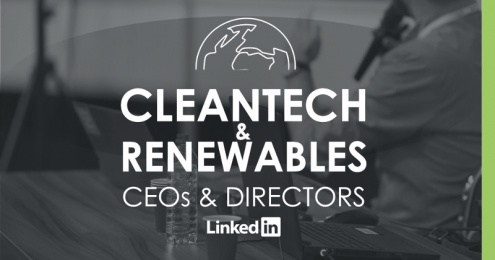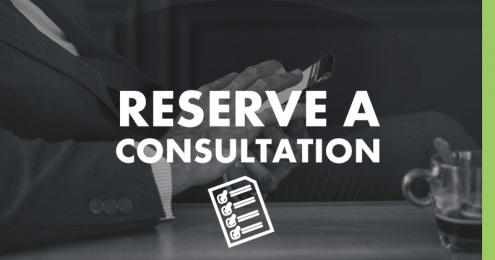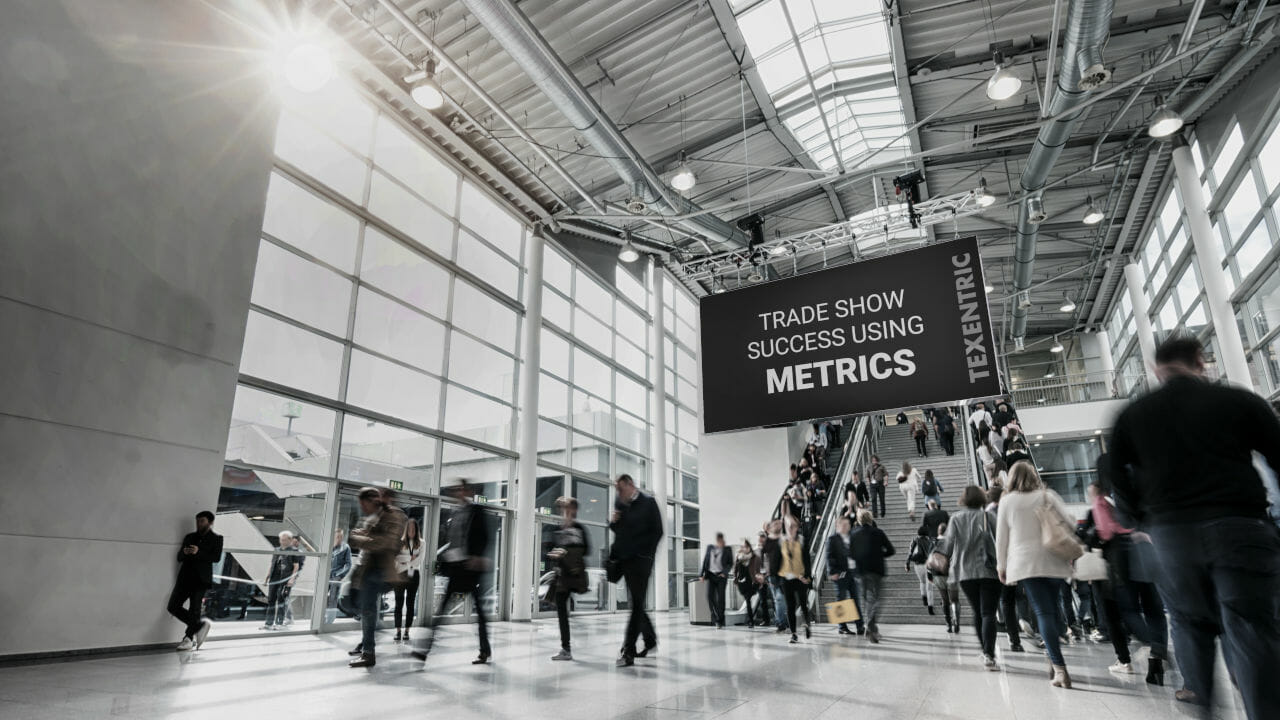
Even when you observe the most successful exhibitors at trade shows, there seems to be so much scope for getting better results. Trade show metrics are often overlooked – as are clear goals.
If you talk to a dozen trade show exhibitors you are likely to hear some admit that they view participation alone as a good enough objective – some kind of “notch under their belt”. It goes without saying that exhibitors aiming to just have a presence are obviously setting the bar too low. This approach is about as proactive as “aiming to exist”.
Even some of the more enthusiastic exhibitors still appear to unconsciously pursue mediocrity year after year because “this is how we have always done things”.
If I had to put down a single reason for the wasted opportunity encountered at trade fairs I’d say it has to do with lack of ambition.
Ambition is the key to great results for exhibitors at trade shows (or any other industry for that matter). If you aim higher, you’ll perform better.
Whether you have a massive budget and dominate the show with your presence or you’re a small exhibitor with just a chair and a table there are so many things you can aim to do better.
Ambition also requires metrics – “what gets measured, gets done”. Combining metrics with ambition will help you aim high, measure, improve and then aim higher next time.
So, let’s get started and take a look at what you can aim for the next time you participate as an exhibitor at a trade show.
Table of Contents
- 1) Gather leads and opportunities, pitch your offering and book appointments.
- 2) Push existing clients and prospects through the sales funnel, build relationships, close some sales.
- 3) Build buzz before, during and after the trade show
- 4) Launch new products / features / services
- 5) Gauge trends and the competition
- 6) Listen to customers, get input, feedback and test ideas
- 7) Build your brand by educating and speaking
- 8) Position your brand properly against your competition
- 9) Engage with influencers and the press
- 10) Mingle and meet people
- 11) Use events as team-building exercises for staff
- 12) Capitalize on your achievements by following up.
- 13) Trade show return on investment (Event ROI)
- 14) Improve! learn what you can do better next time
- 15) Have fun!
- Choose your trade show metrics and objectives wisely

1) Gather leads and opportunities, pitch your offering and book appointments.
It goes without saying that this is one of the most obvious and important goals. To really get the most out of the trade show you should make sure to set some metrics and keep tabs on your progress.
Measure leads, opportunities and appointments by tracking these on a day-to-day basis using your CRM. You may also wish to try out trade-show specific software such as www.myfairtool.com to keep track of everything (thumbs up to Jure Šacer, CEO of TermoPlus for sharing this).
To get more leads, opportunities and appointments it is absolutely key that you plan your trade fair presence thoroughly and that you follow up closely afterwards.
Don’t forget, with GDPR in effect it is crucial that your data collection methods are compliant. Getting a business card doesn’t mean an automatic subscription to your email list anymore!
Relevant trade show metrics: Pre-show appointments booked for new contacts, booth visitors / attendees (separate invites from drop-ins), CRM entries for new leads and opportunities, post-event appointments booked, daily count of meetings / presentations, etc.
2) Push existing clients and prospects through the sales funnel, build relationships, close some sales.
Trade shows offer you physical proximity. In our digital world this is a massive opportunity to build rapport, develop a deeper understanding of prospect needs and to build trust. If you’re not creating or developing relationships at trade shows you are definitely doing something wrong.
Relationship progression is hard to measure but you should try to nevertheless. Use appointments, closed sales and qualitative notes in your CRM to track these.
If you have prepared for the show and your appointment slots are booked you may experience something akin to speed-dating but for professional connections.
Relevant trade show metrics: Number of contacts invited to show, number of pre-show appointments booked for existing contacts, CRM prospect progression in funnel view, sales, qualitative relationship information shared at the show debrief.
3) Build buzz before, during and after the trade show
Since a trade fair presence is a big deal (in terms of both costs and returns) it makes sense that you should aim to maximize any results you get from the show. Time during the show is finite. The only way to improve your performance during the show is to thoroughly prepare for it and follow up after the show.
Social media and the press are a big part of the pre-show and post-show experience. If you don’t build buzz beforehand you won’t get that many visitors during the show. Since expos and fairs dominate press and blog content before, during and after the event you should certainly aim to capitalize on this opportunity.
Relevant trade show metrics: press releases sent and published, social media mentions, number of posts and engagement metrics (shares, likes, re-posts etc), booked appointments as a result of these activities.
4) Launch new products / features / services
Visitors show up at trade shows to see what’s new. The press loves product launches. Even if you don’t have a new product to launch perhaps you can present a new feature, a new service aspect or a package offering.
Although timing product launches with trade shows means your launch may be drowned by the noise of the show, it also means that your presence there has a fighting chance to be covered by the press.
So, aim to time some of your launches to coincide with your major trade show appearances. Don’t forget to tell the press in advance by the way!
Metrics: Number of new features / products launched.
5) Gauge trends and the competition
At these events you can’t afford to lose the opportunity to check out what’s new, where the crowd gathers and their reactions.
Keep a keen eye on your competitors. What are this year’s trends? Where is the market shifting? What are your competitors up to? Pick up a couple of brochures, check out some of their presentations.
If you can spare the time, keep a short “diary” of competitor activities at each show you attend.
Relevant trade show metrics: ideas, trends and insights added to post-show debrief, keeping a show diary or competitor records up to date.

6) Listen to customers, get input, feedback and test ideas
Where else can you find such a massive pool or prospective customers to check out your offerings and give feedback? Before the show give staff a couple of questions to test and probe visitors with. Make it a tradition that this information is captured in writing during or at the end of each day.
Negative comments, concerns, objections and criticism can save you from major blunders and will certainly improve your offering. Ignore this feedback at your own peril!
But you don’t have to just note what is expressly mentioned to you. Keep a keen eye on subtle reactions as well. If you pitch the same presentation twenty times in one morning by the evening you’ll know what to change to get a better reaction.
Exhibiting at a trade show is like a sandbox for testing everything.
Metrics: the successful completion of any testing or research tasks. Negative feedback that can lead to a better offering, new ideas, trends and insights added to the post-show debrief.
7) Build your brand by educating and speaking
There are tons of speaker opportunities at most trade shows. An event can have more than 200 speakers in half as many conference sessions packed in just a few days. Take advantage of opportunities like these and make an effort to be in the speaker list at least once at every venue.
It isn’t always easy getting in on these speaker platforms so here are some tips:
-Get in touch with the organizers early on before the spots fill up.
-Never present a sales pitch. You need to offer something of value.
-Pick a topic that is trending and that you are knowledgeable on. It should somehow relate to your products and their advantages. It should also answer questions that your audience has.
-Take a look at what presentations were made in previous years and put something together that fits in with the event’s style and topics. Sometimes they have separate topic tracks – aim for those that are highly relevant.
-Be consistent but present fresh content each year. With more presentations you’ll get a good reputation that will help you in countless ways.
Relevant trade show metrics: speaker slots applied for, booked speeches and presentations, presentation downloads, views of presentations online.
8) Position your brand properly against your competition
You have probably spent a good portion of your budget towards good booth design, decent collateral and all team members have matching branded shirts and nice new business cards. So that’s a good start, right?
Well, maybe as a start – but that’s just it. The theme isn’t the core of what you should focus on. It is surprising how many things go wrong here.
Everything you do must be in absolute harmony with the way your brand is positioned. This is particularly the case with service aspects of your offering.
At fairs people can get tired and grumpy and this shows. Trade shows require friendly, helpful customer-facing talents and a lot of energy.
Key members of staff are often off on break without a stand-in to cover for them. It is really annoying for visitors to have to come back an hour later because nobody can help them.
Sales technique is important. Don’t mechanically spew out the same poem you recited to your previous visitors. Take the time to ask about the visitor’s needs, understand their situation and treat them as a potential major partner. Just because you get hundreds of people visiting doesn’t mean they should be treated any less than your largest pitch on any other day.
If your brand is about high-quality installation of solar PV panels, have a small-scale demo setup to show visitors the attention to detail you put in your work.
If your offering is IoT analytics for smart homes, show some interesting live data to the visitors and explain how it is different to the competing alternative down the hall.
The list goes on and positioning is a topic that can’t be discussed in depth here. To be blunt, you should treat your brand with real care and not on a superficial level.
Relevant trade show metrics: Pick ten words that best describe your brand and offering and then grade your exhibition presence, staff and behaviours using these words.
9) Engage with influencers and the press
It is crucial that before each show you should send invites to influencers, bloggers, analysts and press contacts. Don’t forget to give them a great reason to drop by.
Interact with them! Be sure the booth staff is aware of the badge coding convention. In many fairs, press and bloggers get a different colour badge or a large “PRESS” stamped on it.
Make sure your team introduces these professionals to whoever is designated to handle press issues. Give them the background info they need and answer their questions. Build a rapport and engage with them. Ask them what topics they are interested in covering and try to be genuinely helpful – don’t give them the corporate drivel that they have to endure during these shows. They are people, not robots! Finally, check you have got their permission to add their contact details to your press distribution list.
Relevant trade show metrics: press distribution entries added, future opportunities arranged, number of mentions in press, articles, social media or blogs.
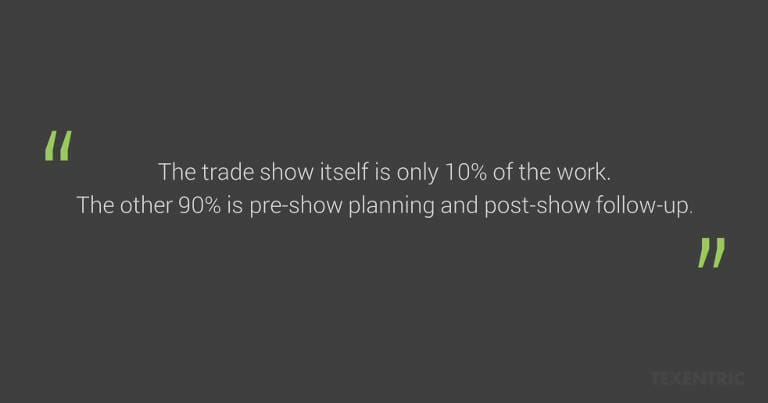
10) Mingle and meet people
Any social interaction can lead to new partners, employees, suppliers or clients. Tap into your excitement and make a conscious effort to be as social as possible. Get introduced and introduce people.
Event time is finite so try not to squander opportunities like these. However, you should be aware of your priorities. At each trade show there seems to be someone with nothing better to do than pointlessly hover around your booth yapping like there is no tomorrow. Keep an eye on time!
Relevant trade show metrics: New contacts made / added to CRM.
11) Use events as team-building exercises for staff
Trade shows are a team effort – just like those expensive team-building retreats where you get to spend a wad of cash for simulated team-building exercises. Only this time you get something more tangible for your money and the opportunity to witness real team dynamics in action.
If, for instance, you’re grooming someone for a leading role, you can assign them a leading role for the fair in order to test their skills, prepare the team for the transition and build the candidate’s confidence.
Intense shows that last four days or more are likely to test a team and bring out the best and the worst in people. It’s a great way to observe what can be improved in the workplace and to get to know your team on a more personal level.
Relevant trade show metrics: keep tabs on performance and morale by writing up a note with your observations at the end of each show. How can you use this to improve team dynamics?
12) Capitalize on your achievements by following up.
Most exhibitors fail to properly follow up after a trade show. This is completely counter-intuitive especially considering all the hard work and expense of gathering the leads at the show in the first place.
What is worrying is that poor follow up is the norm.
So why does this happen? Well, it seems the return to the day-to-day stuff and catching up on the build-up of work play a role.
When you pack up after a trade show you feel a sense of accomplishment – “that went well, I can cross it off the list now”. So, your brain rewards you for a job well done.
The way around this is to make sure everyone sees the end of the trade show as the successful conclusion of the follow-up process.
By setting follow-up as a distinct objective with measurable results, you will find it easier to implement.
What I find works best is two post-show milestone meetings.
The first one is the post-show debrief, where you reflect on goals achieved, metrics, improvements and next steps. This should happen within a couple of days after the fair ends.
The second one takes place between three to four weeks after the trade show and perhaps even more in longer sales-cycles. This one is the post-follow up debrief and is more like a sales meeting. It should cover metrics that relate to the onboarding of new clients and the successful follow-up on leads. This is where real credit should be given and where the end of the trade show can be official.
Relevant trade show metrics: Lead progression metrics & funnel status: leads followed up on, qualified leads, leads not reached etc.
13) Trade show return on investment (Event ROI)
A crucial metric for any marketing activity is its financial performance.
If you’re paying for a €90.000 cleantech trade show presence you should at least aim to get €90.000 in contribution towards the cost of the activity. Further than just breaking even you should also see a positive return.
It’s amazing how often even major exhibitors fail to account for the costs and benefits of exhibiting at a trade show.
Relevant trade show metrics: Return on investment calculations should at least start with the basics:
a) Did the event cover its own costs? Did it contribute to profitability?
Total costs (including pre-show activities, exhibiting costs, staff time, travel, entertainment, post-show follow-up etc) minus sales contributions derived from the show.
b) How did the profitability of this event compare to that of other trade show events?
Compare ROI in both figures and percentages.
c) What other long-term benefits should be considered?
New clients that will be with you for years should be taken into account when you take consider sales. Don’t forget to also take into consideration results from all the goals and metrics discussed here.
This way you should be able to give a clear answer to the aching question: “was it worth it?”.
14) Improve! learn what you can do better next time
As with any marketing activity, improvement can only be a result of reflection.
The starting point here is your objectives. Go through your objectives and metrics to assess your performance in these areas and then make sure you identify what areas can be improved upon the next time around.
Also, there are many tools available for exhibitors that they are often unaware of. Ask the organizers about all the tools and services available (press services, data management, event support, pre-event promotion etc) so as to use them to your advantage. Most organizers even put together checklists and guides and many other resources like this easy planner guide below found on the GPEX website.
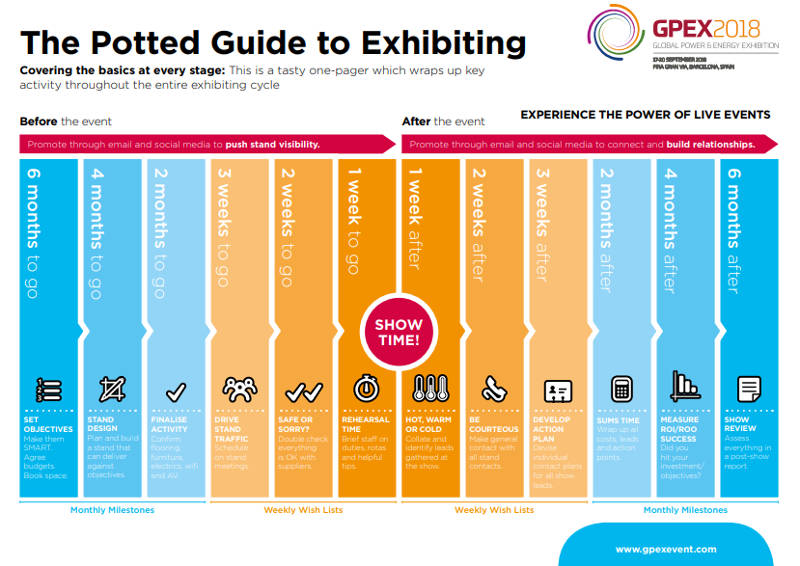
It’s essential that you have a post-show debrief meeting within a couple of days after the show. Ask your team for input and ideas for improvement. Reward good ideas with recognition and make sure they get implemented if they make sense.
Also, test, test and test – don’t just spend money on ad space just because you can.
A note on brochure metrics:
Some exhibitors use the number of brochures handed out as a KPI for trade shows. This is a poor metric since it varies wildly based on booth location and other factors. Although it can be helpful as a baseline metric, you should avoid using it as an objective. When brochures handed out are used as a KPI staff tend to focus on paper-spamming attendees rather than engaging in productive conversations with them.
15) Have fun!
Trade shows are a good opportunity for team bonding. You get spend many hours with the people you work with and it should be a good chance to build personal ties with them.
As with any team effort it is a great opportunity to celebrate team achievements and strengthen relationships. Try to give the event some flair. Make sure the team looks forward to these events despite the demanding schedule.
Choose your trade show metrics and objectives wisely
There are so many things you could get out of a trade fair, alas you can’t do everything. While aiming high is great, you should also not get distracted.
With time being your enemy at a trade show you should focus on the most important goals to you. Be realistic and don’t attempt to achieve all fifteen of these. Instead, pick the four or five that are most important to your business now and go with them. You can however track all trade show metrics mentioned here for the sake of keeping tabs on performance evolution over time.
To give your marketing efforts an extra boost, check out our free cleantech marketing resources.
Nicolas Virtsonis, Cleantech Marketer & Founder of Texentric
Nicolas specializes in international marketing for clean technologies. Nick's focus is on international market entry, technology distribution and growth marketing for tech.

